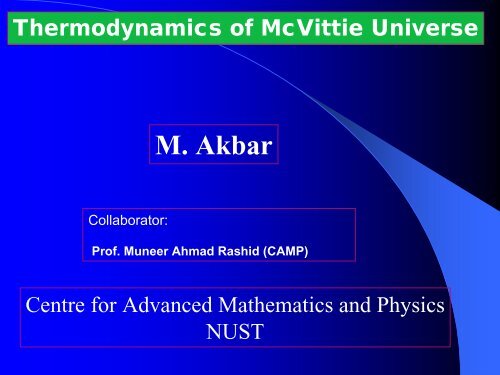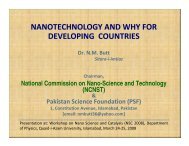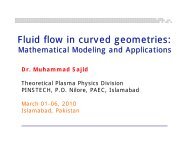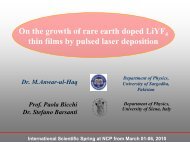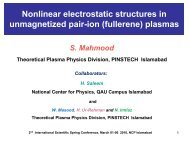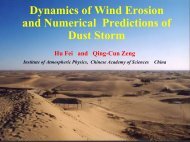Thermodynamics of McVittie Metric - National Centre for Physics
Thermodynamics of McVittie Metric - National Centre for Physics
Thermodynamics of McVittie Metric - National Centre for Physics
- No tags were found...
Create successful ePaper yourself
Turn your PDF publications into a flip-book with our unique Google optimized e-Paper software.
Einstein’s Equations (1915):Ricci TensorGravitational Constant1R − g R = 8 GT2πμν μν μν{Geometry matter (energy-momentum)}C = 1
a) Brief Introduction to Black Hole <strong>Thermodynamics</strong>1. Black Hole Solutions to the Einstein field equation2. Cosmological solutions to the Einstein Field EquationBlack Hole (By Wheeler in 1967):A spacetime region in which gravitational field is so strong thatit precludes even light from escaping to infinityNote: Velocity required to leave the boundary <strong>of</strong> the blackhole is equal to the speed <strong>of</strong> light ( Classical Picture)Penrose (1967):proposed that the black hole must contain non-zero entropy
Bekenstein, Bardeen, Carter, Hawking (1970-1974):Jacob Bekenstein et al proposed that a black holeshould have an entropy, and that it should beproportional to its horizon area.Since black holes do not classically emit radiation,the thermodynamic viewpoint seemed simply ananalogy.Four Laws Black hole <strong>Thermodynamics</strong>Four Laws <strong>of</strong> <strong>Thermodynamics</strong>However, in 1974, Hawking applied quantum fieldtheory to the curved spacetime around the eventhorizon and discovered that black holes emitHawking radiation, a <strong>for</strong>m <strong>of</strong> thermal radiation,which implied they had a positive temperature. Hedetermined the constant <strong>of</strong> proportionality.
Schwarzschild Black Hole: Units G = c =1M = mass <strong>of</strong> the black HoleEvent HorizonSurface Gravity
TemperatureSurface gravityEntropySimple ExampleA = 4π r 2Schwarzschild Black Hole (1916): Mass MhorizonT dS = dMMore general:Kerr - Newmann Black Holes (M, J, Q)dM = T dS + Ωd J+Φd QReference: Black Hole <strong>Physics</strong>, ByValeri P. Frolov and Igor D. Novikov
Einstein’s Field Equation | (At horizon)First Law <strong>of</strong> <strong>Thermodynamics</strong>First by T. JacobsonHe found that it is indeed possible to derive the Einstein equations from theproportionality <strong>of</strong> entropy to the horizon area together with the fundamentalrelation δQ = T dST. Jacobson, Phys. Rev. Lett. 75 (1995) 1260<strong>Thermodynamics</strong> <strong>of</strong> Spacetime: The Einstein Equation <strong>of</strong> StateHorizon <strong>Thermodynamics</strong>: T. Padmanabhan, Class. Quant. Grav.( 2002)[
c) From the First Law to the Friedmann EquationsFriedman-Robertson-Walker Universe:22 2 2 dr 2 2 2 2 2ds =− dt + a ()( t + r dθ+ r sin θdϕ)21−kr1) k = -1open2) k = 0flat3) k =1closed
Friedmann Equations:Where:
Our goal :Some related works:(1) A. Frolov and L. K<strong>of</strong>man, JCAP 0305 (2003) 009(2) Ulf H. Daniesson, PRD 71 (2005) 023516(3) R. Bousso, PRD 71 (2005) 064024
22 2 2 dr 2 2 2 2 2ds =− dt + a ()( t + r dθ+ r sin θdϕ)21−kr
Apparent Horizon in FRW Universe:Apparent Horizon:A marginally trapped surface with vanishing expansion
Apply the first law to the apparent horizon:Make two ansatzes:The only problem is to get dE
Suppose that the perfect fluid is the source, thenThe energy-supply vector is: The work density is:S. A. Hayward, 1997,1998)Then, the amount <strong>of</strong> energy crossing the apparent horizon withinthe time interval dt
By using the continuity equation:1. Cai and Kim, JHEP 0502 (2005) 0502. Akbar and Cai, Phys. Rev. D75:084003,2007
<strong>McVittie</strong> <strong>Thermodynamics</strong>:<strong>McVittie</strong> 1933:<strong>McVittie</strong> <strong>Metric</strong>M 0 = Mass <strong>of</strong> the black holea (t) = scale factor <strong>of</strong> the universeNotice That: M 0 = 0Flat FRW universea (t) = 1Isotropic <strong>for</strong>m <strong>of</strong> Schwarzschild solution
Properties:(i) The metric seems to represent a Schwarzschild black hole embedded in spatiallyflat FRW universe [D. J. Shaw et al Phys. Rev. D73 (2006) and others](ii) As r → ∞, The <strong>McVittie</strong> metric reduces to a Robertson-Walker (RW) universe.(iii) It is singular on the 2-sphere r = M 0 / 2. Also Pressure and Ricci scalar divergeat r = M0 / 2<strong>McVittie</strong> can be rewritten as:ds2AB22 2 4 2 2 2= − dt + a( t)B dr + R dΩ2WhereA =M−2a(t)r1 0B=M+102a(t)r2R=a( t)rB
Apparent Horizon: abh ∂ R∂R = 0abh ab=diag( −AB22,a ( t )2B4)H2R3A−RA+2M0= 0Hubble parameterApparent HorizonCubic equation in apparent horizon radius
The different cases <strong>for</strong> the roots <strong>of</strong> the above equation are obtained bycomparing it withx 3 +p x =q,having discriminant D = (p/3) 3 + (q/2) 2D = -1 ⁄ 27 H 6 + M 02⁄ 4 H 4D > 0 → One real root which is negativeD = 0 → all real roots and two are equal (one positive and one negative)D < 0 → all roots are real and un-equal (two positive and one negative)
Entropy:S = 4π R A2Surface Gravityκ=•H2 M0+ H RA−22 HRAT=κ / 2π
Field Equation at apparent Horizon:Misner - Sharp EnergyE = 4π ⁄ 3 R A2ρ(t) + M 0dS= 2 π RA•dtRT dS = dE +PdWWhere W= (1 ⁄ 2) (ρ –P) is the work density
Conclusion:‣ We worked out the explicit expressions <strong>for</strong>the apparent horizons <strong>of</strong> the <strong>McVittie</strong> universe.‣ The temperatures associated with thesehorizon are obtained.‣ It is also shown that these thermal quantitiessatisfy first law <strong>of</strong> thermodynamics.
Thank You !


